Irish Trade Unions before Congress by Fergus D’Arcy
Published in
18th-19th Century Social Perspectives,
18th–19th - Century History,
Features,
Issue 2 (Summer 1994),
Volume 2
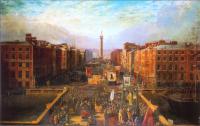
The O’Connell Centenary Celebrations by Charles Russell. (COURTESY OF THE NATIONAL GALLERY OF IRELAND)
On 27 and 28 April 1894 one hundred and nineteen delegates of labour organisations assembled in the Trades’ Hall, Capel Street, Dublin to found the Irish Trade Union Congress. Those present were the inheritors of a labour movement which at that time had over a century of tradition behind it.
In Ireland, as elsewhere in Europe, the eighteenth century saw the births of the first trade unions. It was a process in which miscarriages were frequent, deliveries difficult and the births entirely illegitimate. The mortality rates for the infant Irish trade unions of that and the next century were high, and the childhood of most unions obscure. They were not so obscure however as to leave no traces of their early days and struggles. The surviving correspondence of private individuals and public figures, the files of eighteenth- and nineteenth- century newspapers, and the journals of the Irish and British Houses of Parliament provide many glimpses of the illegal activities of the early Irish trade union movement and of the attempts of employers and of local and central governments to quash them.
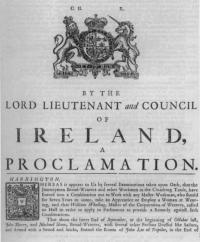
1747 proclamation against combination.
(COURTESY OF THE NATIONAL ARCHIVES, IRELAND)
Combinations
Despite an extensive array of punitive legislation, the labour organisations of Irish workers had come to stay by the time the Act of Union of 1800 had brought an end to the Irish parliament. Punitive legislation continued and was even intensified in the early years of the nineteenth century. The codifying legislation against trade unions passed in Britain and known as the General Combination Law of 1800 was extended to Ireland in 1803 but with stiffer penalties added. Conviction on a charge of trade union membership in Britain carried a sentence of three months imprisonment, but for Ireland this was fixed at six months. This formal prohibition of trade unionism lasted until the statutes were repealed in 1824. Precisely because they were illegal organisations until then, it is difficult to construct a comprehensive picture of labour organisations in Ireland in the early nineteenth century. Even when no longer illegal, trade unions operated in an economic and political climate so hostile that for most of the century they left few formal records of their own. How extensively were working people organised in nineteenth-century Ireland? For the first half of the last century most of what we know relates mainly to Dublin and Cork and to a lesser extent to Limerick and Waterford, joined in the second half by Belfast. The evidence suggests that for much of the century the vast majority of working people were unorganised. Labour organisation was confined almost exclusively to skilled male workers and the latter constituted not more than one-third of the male population of working age. Within that restricted category of labour only a minority in turn would have been unionised at anyone time. Nevertheless the phenomenon of trade unionism was a growing one. Dublin in 1800 had five well-established unions; it had at least twenty by 1825 and over forty-five by 1850. So although only a minority of the capital’s labour force was organised, nevertheless there was a rapid and even impressive growth in the number of trade unions operating down to the foundation of Congress in the 1890s.
British amalgamated unions
Until the middle of the 1820s these labour bodies were exclusively independent local ones. From the 1820s however British amalgamated unions began to recruit workers into Irish branches. Among the first such were the iron moulders in Dublin in 1821, and carpenters in 1827, coach makers in Cork in 1834, bookbinders in 1835, printers in Belfast in 1836 and engineers in Waterford in 1858. By 1870 amalgamated trade unions with British headquarters represented from a third to a half of the organised workers of Dublin. Thereafter, in Dublin, Cork and Limerick and especially in Belfast the presence of British amalgamated unions strengthened greatly until by 1894 the majority of Irish trade unionists were members of British unions. In 1895, for example, the affiliations to the Irish Trade Union Congress consisted of 50,000 members of British unions as against 17,000 members of Irish unions. The growth of trade unionism in Ireland over the period 1800 to 1894 is certain enough. Whether there was a corresponding growth in their power and effectiveness is less certain. One is struck by the general improvement of conditions in some aspects of the life of certain skilled workers in the course of the century. The length of the working week for many tradesmen fell from an average seventy-two hours in 1800 to fifty-four by 1900 and the purchasing power of their weekly wages undoubtedly improved over the course of that time. But equally one calls to mind the several occupations that were forced close to extinction, such as the handloom weavers, the silk workers and the tanners. Nor should one forget that some of the longest and best organised of the traditional craftsmen, such as the bakers and the printers, suffered major reverses in the course of the century .
Child labour in the Irish Times
Thus, the bakers, highly skilled and well-organised and with the support of many other workers as well as that of the general public and the national press, failed miserably in a six-month long campaign in the 1840s to secure the abolition of night work in the bakery trade. At the turn of this century Dundalk bakers for example were still working appallingly long hours. Likewise the printers, those aristocrats of labour, failed to secure a single wage increase over the forty years from 1829 to 1869 despite their skills and organisation. Furthermore, despite their best efforts, they failed to prevent the encroachment of women into Belfast letterpress printing and to stop the employment of children by Major Knox in the production of the Irish Times in Dublin at the end of the 1850s. If it is therefore difficult to establish the positive gains achieved by the infant Irish trade union movement in the nineteenth century, there was one achievement that cannot be gainsaid: they survived and grew as the century progressed. This was no negligible achievement when the economic, political and social circumstances in which they operated are borne in mind. Over the period 1800 to 1850 Ireland was not just a predominantly rural country with a small industrial base but was de-industrialising. Belfast and the north-east after 1850 aside, its major towns were in economic decline as manufacturing centres. They increasingly hosted large pools of unemployed or under employed poor from which a docile and dismissable labour force was easily recruited. Both countryside and towns had a long tradition of violent protest: equally strong was the tradition of successful government counteraction and suppression in which police surveillance was unrelenting as the century progressed. In this situation all organisation among the lower orders was suspect. Country and town constituted a society in which sectarianism threatened to divide worker from worker, and not just in Belfast and the other northern towns. At the same time Ireland was not isolated from the general economic orthodoxies of the age which celebrated the virtues of individualism and deregulation and which increasingly came to resent and reject the older protective attitudes of price control, wage regulation and arbitration. Given these circumstances the survival of the unions was a not inconsiderable achievement. In the very difficult period from 1815 to 1850 it was the unrivalled vigour of the Irish trade union movement in the context of the whole United.
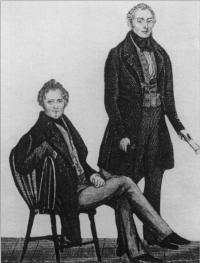
Bronterre O’Brien (seated) and Fergus O’Connor in lB39. (COURTESY OF THE IRISH LABOUR HISTORY MUSEUM)
Reputation for violence
The first trade union historians,Sidney and Beatrice Webb, described the years 1825-40 as the revolutionary period of British trade union history. Then, the Irish unions, especially those of Dublin and Cork, achieved a unique reputation for organisational vigour, and even for violence. There was an unprecedented wave of labour violence in Dublin, a gruesome catalogue of maiming, acid throwing and murder, and in the case of one union in the later 1820s assassination as a calculated instrument of policy. All unions in Ireland acquired a reputation generated by the desperate excesses of the few, the response of people seeing their livelihoods under severe threat and without redress. The skilled workers of the Irish towns in the first half of the century lived upon a collective memory of unparalleled prosperity in the last two decades of the eighteenth century. With the end of the Napoleonic Wars, the onset of post-war depression and the effects of increasingly efficient British competition, much of the urban prosperity, real or imagined, of the later eighteenth century vanished. Against the background of this depression and the loss of a parliament that had brought much business to various trades catering for the aristocracy, gentry and political establishment, the skilled male workers organised to protect their jobs. In doing so they held firmly before them three objects: firstly, to limit the number of apprentices to trades in order to prevent the substitution of adult workers by boy labour under the guise of apprenticeship; secondly, to prevent the intrusion into their trades by non-locals and by unskilled or semi-skilled workers; and thirdly, to resist the imposition of substantial wage cuts which threatened after 1815. In the steadily deteriorating situation in the generation after 1815, it is no surprise that skilled workers organised increasingly into unions, that they offered a stout resistance to the threatened changes, and that this resistance in some cases resulted in considerable violence and even death. In the 1820s and 1830s this resistance took on the proportions of a class war in some cities not dissimilar to what was happening in the countryside. In the process the Irish unions were saddled with the responsibility for loss of trade and economic decline. It was they who chased away business and who frightened off capital. This was the recurrent theme of public meetings of outraged citizens, of indignant editorials and of a parade of employer witnesses before parliamentary commissions of inquiry into workers organisations in Britain and Ireland in the 1820s and the 1830s.
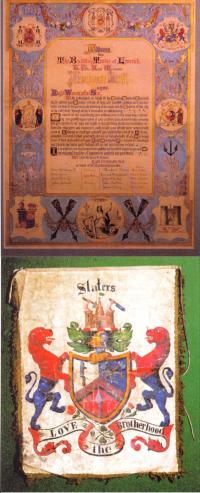
Address from the building trades of Limerick to
the Mayor, A. Hall, 1875.
(COURTESY OF THE LiMERICK CiVIC MUSEUM)
A slater’s apron. (COURTESY OF THE LIMERICK CiVIC
MUSEUM)
O’Connell’s opposition to trade unions
The profound difference of views between organised skilled workers,and their employers and the public came to a head in the notorious conflict between Daniel O’Connell and the trade unions in the winter of 1837-8. This came at the end of a period of great deprivation which saw bread riots in the city of Dublin in the summer of 1837. While that public conflict was an extremely bruising one to both sides, one outcome of it was a new determination on the part of the Irish trade unions to seek the redress of their grievances by means that would be legal and peaceful. From 1840 onwards the unions became seriously concerned to cultivate a new image and to secure the support of public opinion and the press in trade disputes. They sought earnestly to appear reasonable and respectable, as believers in conciliation and arbitration instead of conflict and coercion. Their leaders from the 1840s to the 1880s proclaimed their belief in the community of interest of employer and employed. Indeed, the presidential address of carpenter Thomas O’Connell to the foundation meeting of the Irish Trade Union Congress in April 1894 was the culmination of this very tradition when he spoke of the identity of interest between labour and capital. Appeals to reason and the recourse to public opinion, however, brought meagre rewards in the half century that followed the major conflict of the 1830s.
Trade unions and Repeal
In pursuit of their aims the Irish unions did not confine themselves to the arena of trade disputes and industrial conflict whether conducted violently or peacefully. Political assumptions underlay their economic outlook, shaped their political consciousness and inspired their considerable political activity. With the exception of the skilled and mainly Protestant workers of the industrial north-east after 1850, the majority of Irish trade unionists ascribed their general misfortune to the baleful effects of the Act of Union. Consequently, they saw their general deliverance in the repeal of that Act and in the reconstitution of an independent Irish parliament. This held true from 1830 down to the era of Parnell and beyond. Consequently, although the unions had fierce conflict with employers and O’Connell in the 1830s over trade union rights, they largely shared the political outlook of Daniel O’Connell and moderate Irish nationalism. Indeed the unions of Dublin, Cork and Limerick pressed the cause of repeal of the Act of Union with an earnestness and independence that caused O’Connell some embarrassment during the years of his compromise alliance with the British Whig-Liberals. Throughout the 1830s and 1840s they donated money, held meetings,organised processions and passed resolutions in support of the cause.
Relations with British labour
How far the realisation of a separate legislature would have improved their lot is a moot point. A significant implication of their devotion to that ideal was its effect on relations between organised labour in Ireland and the radical, democratic movement in Britain in the course of the nineteenth century. James Connolly, Ireland’s best-known historian of labour, wrote:As zealous as O’Connell and the middle class Repealers were to prevent any international action of the democracies [of Britain and Ireland], the Irish working class were as enthusiastic in their desire to consummate it.
In this he was hardly correct. From the 1780s to the 1880s, radicals, democrats and working class leaders in England time and again called for a united front of the common people of both countries. John Cartwright in 1798, Henry Hunt in 1819, William Cobbett in 1834, Thomas Wakley in the 1830s, Feargus O’Connor in the 1840s, George Harney and Ernest Jones in the 1850s, Patrick Hennessy and Martin Boon in the 1860s, John Sketchley in the 1870s, Francis Soutter, Joseph Cowen and Charles Bradlaugh in the 1880s did not deny the right of the Irish masses to control of their own destiny but they argued that such control would never be conceded by a landlord-dominated parliament. They urged that English radicals and Irish workers should combine first in a joint effort to secure a democratic parliament and then, presumably, all else would follow. This constant theme in the overtures of English radicals to Irish workers received its most forceful expression and its greatest potential realisation in the Chartist movement from 1838 to 1848.
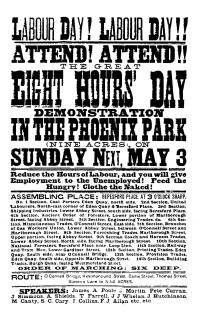 The Chartists and the First International
The Chartists and the First InternationalHowever, as often as these overtures were made, just as often were they rejected. O’Connell personally saw to it that Chartist emissaries would be rebuffed, and they were. Likewise, attempts by the republicanelements of the Chartist movement to link up with the militant Confederate Young Irelanders in 1848 came to nothing. Then in the 1860s the most ambitious enterprises of European radicalism led to the foundation of the International Working Men’s Association, better known as the First International. Here was a body devoted to the common interests of working people across frontiers and one which developed a special interest in Ireland. It failed to secure a foothold in Dublin, never tried in Belfast, started a branch in Cork but failed to sustain it. The most notable feature of the Irish trade union movement in relation to the First International was the entire absence of any official interest. O’Connell and the leaders of Irish nationalism who came after him, from Young Ireliinders to Butt, Parnell and Redmond, were not exclusively responsible for rejection of Chartist and later overtures. The Irish trade union leaders were tough-minded and independent. They preferred to see their deliverance within the fortunes of moderate Irish nationalism. The pattern of political assumptions, attitudes and responses established among the trade unionists in the period 1800 to 1850 held good for the next forty years. Can we call this an ideology? Hardly that: it was more an intuition, a prejudice or a set of assumptions rather than a systematic body of ideas.
Serious critique of society absent
The almost complete absence of any serious critique of the society of which they were a part is striking as is the almost total isolation of organ-ised Irish workers from ideas concerning the nature of poverty and wealth which were gaining currency in Britain and the continent at the time. The Irishman William Thompson, who laid one of the major foundation stones for radical ideology in Britain and Europe through his seminal Enquiry into the Nature of the Distribution of Wealth, was apparently an unknown to the Irish labour movement before the 1890s. It is equally curious that that other influential Irishman, James Bronterre O’Brien, the schoolmaster of Chartism, who laid one of the foundation stones for the theory and movement for land nationalisation in Britain, was also virtually an unknown among the workers of his home country.
It is not that the Irish trade unionists of the mid nineteenth century were completely devoid of a language of labour or of a sense of class solidarity. From the 1840s they developed a language of the rights of labour but the range of those rights was modest in the extreme: a right to a fair day’s pay for a fair day’s work, and a right to a fair hearing, rather than a right to the full product of their labour. They displayed a remarkable solidarity in supporting each other in strikes and in refusing to betray the names of colleagues involved in direct action in labour disputes. However, the predominant sense of political and social identity was not based on or confined to their own class, but was a sense of identity shared with the wider community.
This is evident in the trade union leadership’s declarations of the common interests of capital and labour which dominated their public utterances from the 1840s to the 1890s and which conceivably may have been a rhetorical stratagem. It is strikingly evident on a number of public occasions in the course of the century. Thus, some ten thousand organised workers marched in procession to mark the laying of the foundation stone for the Catholic University in 1862, at a time when not one of them would have had the chance of even a secondary education for themselves or their children. Two years later, ten thousand marched again to mark the laying of the foundation stone for a monument to Daniel O’Connell, hardly a noted friend of Irish labour and trade unionism. Clearly they identified with a vision of Ireland triumphant rather than a particular vision of labour triumphant. In short, those of them who were not Unionist in the political sense, and this was the majority, shared the political hopes and supported the political campaigns of Irish nationalism. Those of them who were Unionist in the political sense naturally identified their interests with those of the wider imperial community. Here again, they took their view from their own experience and perceptions. Although it was a view shared with their own wider political community it was arrived at and maintained independently of the major political figures of their own persuasion in just the same way as Dublin, Cork, Limerick and Waterford’s nationalist workers held their nationalism independently of the leading figures of the wider community from O’Connell to Parnell.
Yet, although one notes the relative barrenness of ideas in the world of Irish labour and trade unionism in the half century after Europe had been convulsed by the revolutions of 1848, one is also compelled to acknowledge the continued survival and even growth of the trade union movement in a time of declining population in Ireland. Not only did the number of unions increase steadily but the type of skilled worker brought into the fold was also enlarged beyond the scope of the traditional trades and crafts. Skilled workers in transport, notably railway men and crane drivers, joined the ranks, as did primary school teachers from 1868. Furthermore, significant attempts were made to form inter union structures, from the United Trades’ Association in Dublin in the 1860s. The first permanently successful attempts however came in Belfast and in Cork where Trades’ Councils were established in 1881, while the Dublin Trades’ Council found permanency from 1886. It was from these organisational developments that the Irish Trade Union Congress stemmed in 1894. This organisational growth however, was very much a case of a little more of the same again. The kind of working people who formed these bodies was not new. The typical views they espoused had not changed in fifty years. The world they inhabited was still bound by the narrow concerns of their own trades. It was not until the 1890s that a profound change commenced as the unskilled general workers began to be permanently organised for the first time and that marching in procession began to occur for the cause of labour rather than the cause of nations. The first May Day march in Irish history was held in 1890 and was symptomatic of the birth of a new age.
Fergus D’Arcy lectures in history in University College Dublin.
Further reading: J.W. Boyle, The Irish labor movement in the nineteenth century (Washington 1988). E. O’Connor, A labour history of Ireland 1824-1960 (Dublin 1992). J.D. Clarkson, Labor and nationalism in Ireland (New York 1925). F.A. D’Arcy & K. Hannigan (eds.), Workers in union: documents and commentary on the history of labour (Dublin 1988).
This article was the first of the recent RTE series of Thomas Davis lectures (producer. Michael Littleton) entitled Trade Union Century. The fourteen lectures will shortly be published by Mercier Press (editor. Donal Nevin).




 The Chartists and the First International
The Chartists and the First International















